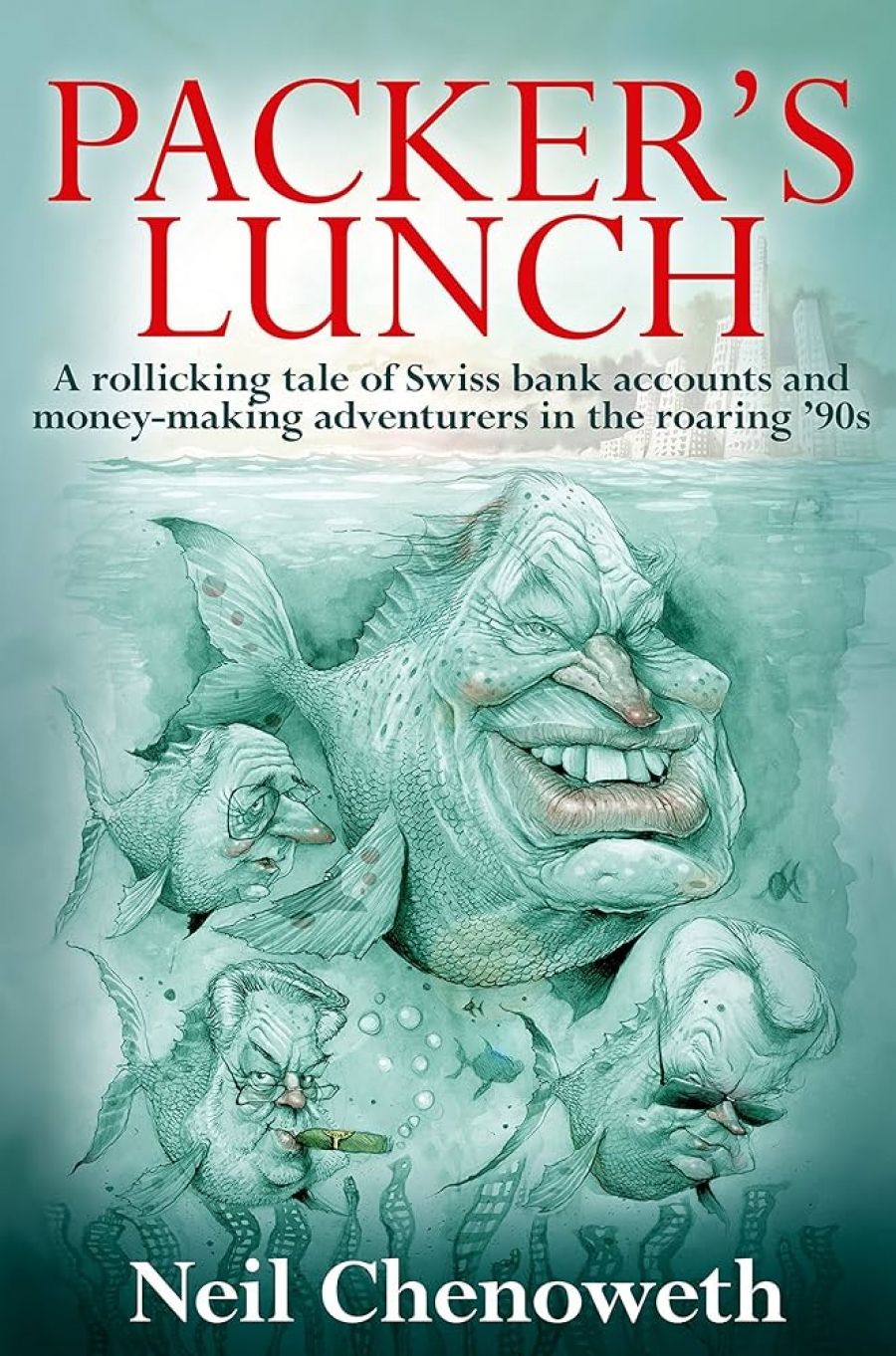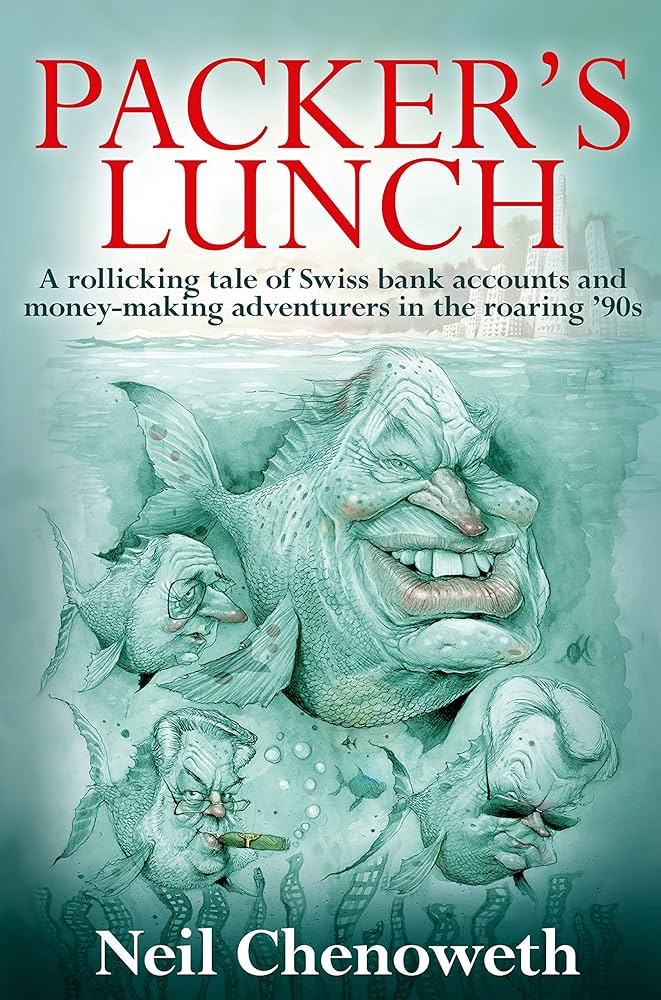
- Free Article: No
- Contents Category: Non-fiction
- Review Article: Yes
- Article Title: Unholy triumvirate
- Online Only: No
- Custom Highlight Text:
One of the three central protagonists of Neil Chenoweth’s book, Graham Richardson, famously titled his autobiography Whatever It Takes (1994). Despite the title’s hints at candour, Richardson’s book eluded all but the most passing references to Kerry Packer. As Chenoweth points out in his alarming new book, this, from the man John Button had dubbed the Minister for Kerry Packer, represented storytelling at its most elliptical. More than Richardson’s book, Chenoweth presents the tale of Whatever it Took. It is not an edifying spectacle.
- Book 1 Title: Packer’s Lunch
- Book 1 Subtitle: A rollicking tale of Swiss bank accounts and money-making adventures in the roaring 90s
- Book 1 Biblio: Allen & Unwin, $45 hb, 356 pp, 1741145465
- Book 1 Cover Small (400 x 600):

- Book 1 Cover (800 x 1200):

Packer’s Lunch is a snouts-in-troughs affair. While grotesquely evocative, the title may mislead. Packer’s Lunch is less about Kerry Packer than it is about the jostlers scavenging for crumbs at his feet: ‘Even a tiny piece of a Packer deal – or the appearance of a piece – can shower wealth indiscriminately on those close enough to catch it. The key is proximity.’ Few careers attest to this more than those of Chenoweth’s key players: Richardson, Rene Rivkin and Trevor Kennedy.
Few have been closer to the machinations of this un-holy triumvirate than Chenoweth, one of Australia’s foremost investigative journalists. Part of the Australian Financial Review team awarded the Gold Walkley in 2004 for its exposé centred on Rivkin’s Swiss bank accounts, Chenoweth has trailed Rivkin’s ensuing disgrace. Much to the chagrin of both Richardson and Kennedy, Rivkin’s loquacious testimony at the Swiss district attorney’s office dragged them into the maelstrom. As revealed by the Australian Financial Review in 2003, Rivkin casually let slip to the Swiss authorities that his erstwhile pals – contrary to their denials – held the mystery parcels of Offset Alpine shares whose ownership the Australian Securities and Investments Commission had been attempting to unravel for a decade. With suspected links to insider trading, arson, and the death of a former model, this was no ordinary Swiss banking scandal.
Much of Packer’s Lunch is devoted to sifting through the detritus of the burnt-out Offset Alpine printing press. Described by Packer as ‘a very good fire’, the inferno led to a handsome insurance pay-out, a hike in the Offset Alpine share price, an arson squad investigation and a share-trading imbroglio centring on Rivkin, Kennedy and Richardson. The flames that engulfed the printing press are also an intriguing and sinister aspect of the murder charge laid earlier this year against Gordon Wood, Rivkin’s former ‘gofer’. Whether or not the death of Caroline Byrne, Wood’s former girlfriend, was related to her knowledge of the circumstances of the fire, has been the subject of speculation for years. Chenoweth’s forensic examination of the shrouded details and shady circumstances of Byrne’s death does little to dampen suspicions.
For all the fortunes lost, reputations tarnished, and friendships betrayed, Chenoweth clearly identifies the one true tragedy in this tale, most powerfully expressed in his searing indictment of the ‘way of life … based upon secrecy, hidden channels and rewards for insiders’ that did so little to shed light on Byrne’s death. Whatever the circumstances were, Chenoweth depicts a network whose suspicions were coupled with the fear of exposing their own Swiss links: ‘For the tax avoiders, Swiss banking had always been a victimless crime. Now, no one could be so sure. Their silence spoke volumes. One could find many names for such moral equivalence. But no one would ever mistake it for decency.’
While Byrne’s death is far from peripheral to Chenoweth’s narrative, those looking for a murder mystery should look elsewhere. At the heart of Packer’s Lunch are the labyrinthine financial dealings central to the world in which these men operate. It takes a writer of rare skill to navigate the reader through such complex terrain, and Chenoweth manages the task deftly. He does much more, however, than simply make sense of the tangled transactions and furtive finances of his protagonists, the book’s great achievement being its ability to weave its disparate strands into a broader narrative that takes in the political and cultural spheres as well as the corporate. This is a book about the shifting sands of the power structure within Australian society.
To come to grips fully with the changing contours of power charted in Packer’s Lunch, which focuses on the last fifteen years, it is necessary to understand how the table was set in 1990. Chenoweth’s distillation of the inflationary consequences of the collapse of the Bretton Woods agreement that had underpinned the international monetary system since World War II is masterfully concise: ‘Put simply, if you were rich in 1970 and did not remake your fortune in the next two decades, by 1990 you were no longer rich.’ When 1990 came, following the recession we had to have, Packer was the ‘last great whale … for the next decade he would be the biggest mobile source of capital in Australia’. But the Packer we are introduced to in 1990 is not keen to shower largesse. In a memorable opening, Chenoweth describes a chastened Packer’s return to Channel Nine following Alan Bond’s brief stint at the helm. Packer, who had repurchased the station from Bond for a fifth of what he had sold it for three years previously, marauds through the building, lashing out at any sign of excess. This tightening of the belts was emblematic of the decade that would follow, a decade in which such celebrated lunchers as Rivkin, Kennedy and Richardson would be forced to fight ‘a rearguard action’.
Chenoweth is spoilt for anecdotes from which to choose as he depicts the pursuit of Mammon undertaken by his subjects. While the tale is salted with mordant comments at their expense, and at times his judgments are unsparing, it is clear that he retains for each of them a sense of affection. This is particularly the case for Rivkin. For all his ostentatious displays of wealth – the gold worry beads, the cigars – he is presented by Chenoweth as a far more complex creature than the cartoon capitalist image he assiduously cultivated.
In keeping with the book’s rollicking tone, each of the first five parts is introduced with a quote from The Pirates of Penzance. The plot of this Gilbert and Sullivan operetta centres on a nurse mistaking a father’s instructions to leave his orphaned son in the hands of ‘pilots’, leaving him instead with ‘pirates’. It is the piratical antics depicted in Packer’s Lunch that make for such entertaining telling. It is clear that Chenoweth feels some regret in drawing the curtain on his characters. And why not? From Packer to Rivkin, his stars are direct from central casting. The closing chapter reads as something of a lament for a bygone era, as the entrepreneur showmen prepare to make way for the investment bankers, consultants, and money managers whose rise is depicted as having ushered in a drab conformity. How much less entertaining a tale might this have been had ‘pilots’ done the parenting as per the bequest? Chenoweth hints that, following ‘the ascent of the suits’, we are about to find out. But, if Chenoweth’s final ambitious extrapolation is to be believed, we are not so much the audience as the orphaned child: ‘this is not merely a change in stakeholders at the big end of town. It is a change again in the way we live.’
The reader may find this claim hard to stomach after 350 pages set in Sydney’s prestigious restaurants and boardrooms. However, for a story that is essentially about the rapacious deeds of a small, Sydney-centric coterie, Chenoweth’s portrayal of the wider ramifications is convincing. Either way, Packer’s Lunch leaves us with much to digest.


Comments powered by CComment